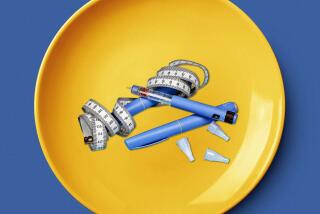A big dream: to be a ‘Loser’
- Share via
They didn’t come to downtown’s Pershing Square on Sunday for the organic kale recipe or the Hula Hoop lesson, the orthodontist or the Laughing Yoga.
They came to the “Shape Up America” health and fitness fair for only one thing:
A chance to audition for “The Biggest Loser.”
The reality TV show that makes losing weight both an arduous competitive sport and a humiliating public spectacle held a casting call at the weekend expo.
When I got there, more than 200 seriously overweight people had been waiting for hours for the 10-minute group interviews that would put them in competition with tens of thousands of others for the 12 spots on “The Biggest Loser” next season.
That’s tens of thousands of people who are morbidly obese.
I was determined to question them with tact and sensitivity. Their brutal honesty put me at ease.
“We know we’re fat,” said Heather Murphy -- 28 years old, 275 pounds. “You try carrying around an extra 150 pounds and tell me what you feel.”
What I wanted to feel, and understand, was how desperate you have to be to stand in your skivvies, with rolls of fat spilling over your pants, on a giant scale that broadcasts your weight to a national television audience.
Christine Clemens -- 30 years old, 315 pounds -- was trying for the third time to make the cut. In San Diego, she said, more than 1,000 would-be contestants overwhelmed screeners, who canceled the tryout. She camped out overnight at the NBC Studios auditions but never got a callback.
Clemens and her husband, Richard, want desperately to have children. Her weight led to a miscarriage four years ago, she said.
“My doctor told me I’ll never have kids if I stay this heavy,” she said.
She’s always been big, but never like this. “I was a [size] 22 when I met my husband. Now I’m a 32 and can’t even button my pants.” She gained 50 pounds in the last year, she said, since the couple lost their home and moved in with her in-laws in Barstow.
She said she’s tried to lose weight on her own. She walks the dog each night and eats “mostly fish, chicken and salads, with dried cranberries for snacks.”
But at her size, a 10-pound loss barely shows up. “I need something to push me past my limits,” she said. “This feels like my only chance.”
As we talked, a pair of model-thin girls in skin-tight pants and bikini tops moved through the crowd, distributing show applications. On stage, fitness trainers were leading about two dozen hardy contestants in a warm-up dance -- “C’mon, try to touch your toes!” -- to a Michael Jackson playlist.
“Biggest Loser” tryouts have been crowded all over the country this month. And the contestants are getting larger -- the biggest was 526 pounds last year -- with more challenging health problems.
The popularity of the show is a sign of America’s obesity epidemic -- one in three of us is heavy enough to be considered obese -- as much as our fascination with stardom.
But it’s also a reflection of how difficult it is to shed weight when you’re pushing 300 pounds or more.
“I would rather not be here,” said Roy Vincent -- 46 years old, 480 pounds. “I don’t want to be the next American Idol. Just let me be thin and healthy.”
Years ago, he lost 299 pounds after a gastric bypass, dropping from 514 to 215 pounds. “I’m fat with periods of thinness,” he said. Then, he could walk into a store and buy clothes off the rack, choose a restaurant by its menu, not its seating plan.
But the stress of caring for his disabled wife led him back to “addictive eating,” he said. “It’s like going through rehab, then you start drinking again.”
Even a win on “The Biggest Loser” is no guarantee the weight will stay off. Several contestants, including former winner Erik Chopin and runner-up Kai Hibbard, put a lot of the pounds back on when the show wrapped up.
Vincent is painfully aware that the odds are against him. I asked if he wasn’t embarrassed at the prospect of baring his body -- and his failures -- on national television.
“The embarrassment,” he said, “is walking around like this.”
It wasn’t just the promise of pounds lost that lured the crowd. It was the promise of a new life, a fresh start.
Everybody had a story to tell: destructive habits, a genetic bad draw, the sorts of problems and emotional pain that turn other people into addicts or workaholics.
This wasn’t about having a Hollywood body or becoming a star. It was about the hope that training, counseling, nutrition advice -- and the scrutiny of a cheering public -- can do what years of private struggles with diets and exercise have failed to accomplish.
They want knees that don’t ache and feet that don’t hurt. They want to find someone to marry, or to live to see a grandchild. They want to blend into a crowd or walk into a room without people gawking.
Or, like Marianna Castillo -- 22 years old, 390 pounds -- they want to “fit into cute things” when they go shopping.
She drove down with her mom and dad from Modesto for the tryout. “I need to be on that show,” she said. “I can bust it out. I’ve got heart for days.”
What she doesn’t have is money for a personal trainer, or an appetite for organic kale salads. “I don’t even really know what it takes to be healthy,” she said. “I got a gym membership, but you walk in and there’s a room full of skinny people.
“I’m 22 years old and still wondering how I got here,” she said. “It’s like you wake up and you’re big; this is just the way it is.”


